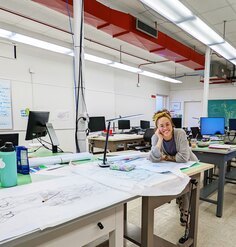Olmsted Scholar Feature: Towards a Greater Knowledge Base
By Bram Barth, 2010 University Olmsted Scholar
In 2002, Michael Speaks, Dean of the College of Design at the University of Kentucky, coined the phrase ‘design intelligence’ in a series of articles for A + U magazine to describe “that ‘unseen’ array of techniques, relationships, dispositions, and other intangibles, that enables post vanguard practices to innovate by learning from and adapting to instability, and in so doing to distinguish themselves from their vanguard predecessors.” I use the phrase here to represent the bricolage of knowledge that individuals, firms, project teams, etc. possess that allow them to not only operate at the most basic design levels but more importantly, to build upon in order to push their bounds. Indeed, these intelligences come in multiple forms, including extended periods of professional experience or cultivated research as well as interpretation of real-time field data and awareness of pertinent current events.
Subsequently, my research focuses on framing the role of intelligence within the discipline of landscape architecture, utilizing the Chicago River Watershed as a vehicle of study. Inspired by the works of design strategists such as Alan Berger, Associate Professor of Urban Design and Landscape Architecture at the Massachusetts Institute of Technology, I have begun an assemblage of regional data sets based primarily in GIS technologies. Also included is a preliminary inventory of existing institutional frameworks. In this sense, a marriage between the understanding of ecological dynamics, infrastructural systems, and human organizations has begun to emerge that spans multiple scales.
Particularly challenging is the navigation between the polar extremes of these scales, namely regional planning and site design, where a quote from Berger’s Systemic Design Can Change the World has served as a guide – “I promote using the new tools of analysis [GIS, www, etc.] to expand site program and strategy outward, adjusting and feeding back small-scale issues based on large-scale logic all the way through the design process. The resulting project is smarter and more sustainable [able to live without expensive, infinite inputs] if larger scale logic is embedded in the smaller scale proposals.”
Utilizing my collection of data sets in a series of regional analyses, I have begun to examine large-scale relationships and connections that might not otherwise have been observed. Common characteristics among landscapes that are miles apart have surfaced, revealing potentially unexpected bases for design collaboration. Additionally, details associated with single sites have served to distinguish and clarify their role in larger contexts. In this manner, sites are never reduced to isolated parcels but rather remain viewed in relation to the whole. Given the large scale of the Chicago River Watershed, however, this type of analysis is virtually limitless where my work up to this point has only begun to scratch the surface.
For more information over the coming months, research findings and design engagement will be posted at www.brambarth.com.
Bram Barth earned his undergraduate degree in Landscape Architecture from Ball State University and is currently pursuing his MLA at the University of Illinois in Urbana-Champaign. Following graduation, he will return to practice as a licensed landscape architect for WRD Environmental, an ecological consulting firm based in Chicago. For questions regarding his research and work, he may be contacted at barth4 [at] illinois.edu (barth4[at]illinois[dot]edu).











